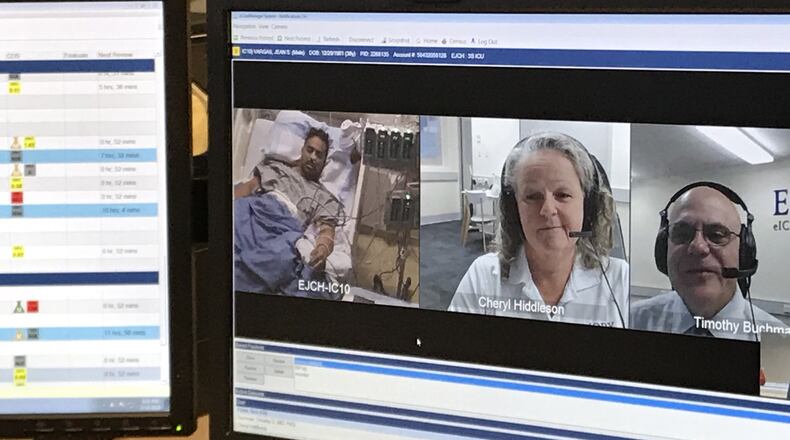About four years ago, Dr. Tim Buchman groggily called a colleague after working yet another night shift. In 2014, Buchman, director of the Emory Critical Care Center, worked a total of 180 night shifts — 7 p.m.-7 a.m. — and the harsh realities of working evening hours were taking their toll.
He was more irritable, more snippy and his ability to focus was impaired by a lack of consistent, quality sleep.
“We started talking about how to make nights better,” recalled Cheryl Hiddleson, a registered nurse and director of the Emory eICU (electronic intensive care unit). “And then I remember he said, ‘We have to figure out a way to turn night into day.’”
Amazingly, Buchman and Hiddleson are doing just that, and it’s a move that gives patients easier access to doctors at all hours of the night.
In what is heralded as the first of its kind, Buchman and Hiddleson have just launched a new Emory Healthcare project that sends one physician and one nurse to the other side of the globe in Australia. Using remote electronic intensive care unit (eICU) technology by Philips, Emory Healthcare workers begin their day in a control room at Royal Perth Hospital in Perth, Australia, with a 12-hour time difference. In other words, staff begin their shift at 7 a.m. in Australia, 7 p.m. local time.
Specialized cameras, video monitors, microphones and speakers are installed at four of Emory's hospitals, including Emory University Hospital, Emory St. Joseph's Hospital, Emory Johns Creek Hospital and Emory University Hospital Midtown, as well as at a small community hospital — East Georgia Regional Medical Center in Statesboro.
The eICU concept — an electronic intensive care unit staffed by intensivists (board-certified specialists trained in the management of critically ill patients) — is not new. There are about 50 eICUs across the country, outfitted with video cameras, alarms and other monitoring tools helping keep an eye on the sickest of patients no matter where they are in the country. Emory already has an eICU at St. Joseph’s Hospital (there since 2014), which they continue to staff around the clock to monitor multiple Emory hospitals and the regional hospital in Statesboro. Buchman was one of the doctors working there most nights.
But Emory has now figured out a way to set up an eICU in Australia to monitor and care for patients from the other side of the globe. Philips, which provides the platform for virtually every electronic intensive care unit, said Emory is charting new territory in health care.
The Atlanta Journal-Constitution recently spent time at Emory St. Joseph’s Hospital in the ICU as well as inside the control room at the hospital to see the system in action.
“This is the first of its kind,” said Karsten Russell-Wood, head of Global Marketing, Philips, Patient Care Analytics. “Emory as an organization is challenging the paradigm. What they are doing is saying we have to disrupt health care and embrace new models.”
Buchman and Hiddleson, currently in Perth, said there’s been no shortage in volunteers. And there are plans for expansion.
Shortly after 7 p.m. on a recent evening, Jean Vargas, a 36-year-old patient at Emory Johns Creek Hospital, gets a video call from Buchman, who is starting his day in Australia. Buchman asks Vargas about how he’s feeling, and remarks that overall, it sounds like Vargas seems to be improving.
Care teams at the bedside in Atlanta remain the primary caregivers. They are the ones taking temperatures, drawing blood. The health care workers in Australia are designed to provide critical backup support. The eICU team in Australia has real-time access to vital signs, blood tests, X-rays, medications and other information from the bedside of Vargas and others using computers and high-speed data lines. Hiddleson said the team in Australia can quickly notice changes in a patient’s condition such as a change in blood pressure, heart rate or respiratory rate. The goal is to spot these changes before a serious situation turns dire.
Vargas of Suwanee suffered gastrointestinal bleeding and arrived at the emergency room at Johns Creek about a week ago. He’s been in the ICU since, undergoing several procedures and surgery. He’s had several conversations with Buchman during his stay.
“I couldn’t believe he was in Australia,” he said. “I thought he was just down the street. It’s been great.”
He said it was good to know he had access to a doctor in the middle of the night, and he had no problem with the conversations taking place through a high-definition video screen. His wife agreed.
“It’s been nice when your doctors during the day have gone home, but in the middle of the night, if we have questions or we are nervous about something, to have that access to doctors like this, it’s very comforting,” said Rebekah Vargas.
MORE: Andrew Young 'resting' at Emory University Hospital after medical scare
This new program, which started about a week ago, places Emory staff in Australia for stints lasting between eight and 16 weeks. The idea took root after that fateful morning conversation four years ago.
They considered a few places with big time differences, including China and Singapore. But when they approached the staff with the idea, and Buchman threw out the idea of Australia, home to sand-covered beaches, and no language barrier, all hands went up. Since then, Buchman and Hiddleson have been ironing out logistical and technical issues, ultimately deciding to connect all computer equipment in Australia to Emory networks, and to have all equipment be on local time.
Moving clinicians to a different time zone addresses two of the biggest challenges in critical care night staffing: a shortage of experienced clinicians willing to cover night shifts, and the immense emotional and physical stress of working nights.
Hiddleson said before the eICU centers were set up at St. Joseph’s and now Australia, doctors on call at night were getting calls between eight and 10 times a night. And calling a doctor in the middle of the night who may be sleeping or trying to sleep is not an ideal time to discuss a health care emergency.
With the eICU in Australia, the number of calls dropped to just twice per week. A recent study by Abt Associates for the Centers for Medicare and Medicaid Services (CMS) (which provided Emory with a $10.7 million grant to expand its remote intensive care units into North Georgia) also found Emory’s eICU program resulted in a trend toward shorter ICU and hospital stays and reduced costs in medical care costs because patients were more likely to go home after a hospital stay instead of going to a skilled nursing facility for longer-term care.
Hiddleson, a longtime critical care nurse, recalled working the night shift early in her career when her children were young.
“It was very difficult,” she said. “I was tired all the time. I was overeating and not exercising and 40 pounds overweight.”
As a nurse practitioner who works the night shift at St. Joseph’s Hospital, Katie Casey said it’s been helpful to have the support from a doctor on the other side of the screen, especially in rarely seen diagnoses or in emergency situations when a patient’s heart stops or in other cases when a patient requires immediate intervention to avoid catastrophe.
“Sometimes you get a diagnosis you’ve only seen in textbooks,” she said. “It’s helpful for me to have someone with expertise 24 hours a day to make sure we are doing everything we can to help that person’s care.”
MORE: Emory University joins effort to graduate more low-income students
She said she can tap an emergency button in a patient’s room and connect with a critical care physician in 30 to 60 seconds. A monitor in the room, which looks like a second TV, allows face-to-face conversations. Medical staff can zoom into a patient’s room to see the small numbers on a ventilator.
For Hiddleson, working in Perth was the first time she traveled outside the country. She’s been exploring the beach line of western Australia, hiking, cycling and recently did a yoga class on the edge of the Indian Ocean.
Meanwhile, Buchman said working a 7 a.m.-7 p.m. shift in Perth, Australia, has been transformational for the staff — and himself. On a recent evening in Atlanta but morning in Australia, Buchman couldn’t help but snap a photo on his way to work. Instead of darkness falling, he walked toward his job under a sun shining, blue skies dotted with white fluffy clouds and wispy pink streaks. The birds were chirping.
“This really is a dream come true,” he said.
DANGERS OF WORKING NIGHT SHIFTS
A growing body of research finds a wide range of health risks associated with working night shifts — from a higher risk of coronary heart disease and diabetes to weight gain and some cancers. These findings are particularly strong for those who do shift work — bouncing back and forth between nights and days.
Most sleep doctors will agree that it’s not natural or healthy for humans to fight against their circadian clocks and work at night.
Dr. Tim Buchman, 63, said over his career spanning three decades, he’s worked several thousand nights. He and others who work nights struggle with everyday things most take for granted. They must decide between sleep and going to the dentist or going to a daughter’s ballet recital or dinner with a spouse. Good, quality sleep during daylight hours can be hard to come by.
About the Author
Keep Reading
The Latest
Featured







